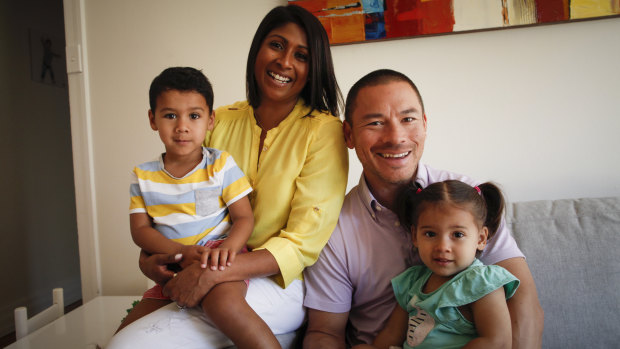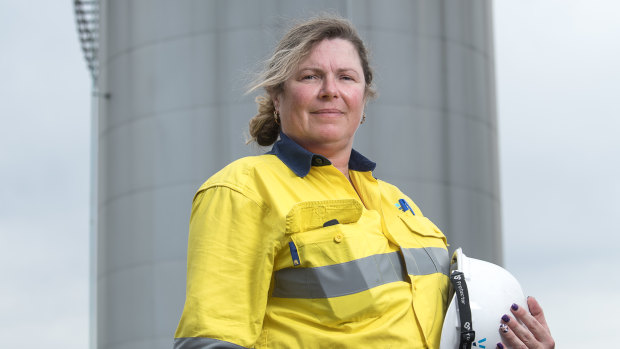By Anna Patty
Pam Gavan never imagined she would get a promotion when she returned to work part-time after taking a year off on maternity leave.
Mrs Gavan, 40, was a general manager of recruitment and engagement at Medibank in Sydney before taking leave. When she returned in August last year, she was promoted into a more senior role that made her responsible for managing a larger team of staff and teams of doctors.
"I was very surprised with the opportunity," she said.
"I had great support from my previous and current manager. I was moving into a whole different area that I had not shown my capability in."

Pam Gavan with her son Hunter (3) and daughter Zoe (2) and husband Jonny.Credit: Dean Sewell
Ms Gavan's story comes as the latest annual snapshot from the Workplace Gender Equality Agency (WGEA) shows the gender pay gap fell by 1.1 per cent last year.
The biggest single-year drop in the gender pay gap has reduced it to 21.3 per cent, but men still take home on average $25,717 per year more than women.

Libby Lyons, Director of the Australian Government's Workplace Gender Equality Agency Westpac
"And the reason it is dropping is because employers are taking action," WGEA director Libby Lyons said. "It's the biggest drop we've seen over the five years of collecting data.
"Now nearly 40 per cent of all managers are women and over the five-year period we have seen a steady increase. "That is really fantastic because 43 per cent of all promotions into management went to women as well.
"If that trend continues we'll hit that magic 50-50 number soon."
However, the pay gap has increased in favour of men for the second year running in Australia's most female-dominated industry. The gender pay gap among health workers increased from 14.7 per cent in 2015-16 to 16.1 per cent in 2017-18.
"It is time for the healthcare industry to take some action. They must address this issue," Ms Lyons said.
The pay gap increase in favour of men was because the majority of the managers in the health industry are male.
"Clearly, either their wages are going up year-on-year or there are more men moving into management. The people who are doing the high-value caring work are not seeing the benefits," Ms Lyons said.
"We have to even that balance. We have to see more women in management and more men coming into those important caring roles that dominate the health care and social assistance industry."
The pay gap in the male-dominated construction industry has also increased by 2 percentage points to 29.4 per cent. But the mining industry had reduced the gap by 5 percentage points.
The Financial and Insurance Services industry still has the highest pay gap at 30.3 per cent, but it has dropped by 6 percentage points over the the past five years.
While many organisations had policies and strategies in place to improve pay parity, managers were not being made accountable for putting them into action. There has been a 4 percentage point increase to 41.6 per cent in the proportion of organisations that analyse pay data.
"Although more employers are analysing their pay data, over 40 per cent of those who did took no action to close the gap," Ms Lyons said.
"Access to parental leave has ground to a halt. Although the proportion of women in management has increased, most senior roles, especially at the CEO level, are still dominated by men.
"Again this year, there is virtually no improvement in the number of women around Australia's boardroom tables. Just over 35 per cent of the boards and governing bodies in our dataset have no female members."
The proportion of female CEOs increased slightly by 0.6 percentage points to 17.1 per cent and female representation on boards crept up by 0.9 percentage points to 25.8 per cent.
Ms Lyons said the proportion of more than 30 per cent of managers who report to CEOs are women.
"If we see that trajectory continue then I believe in the next five years or so we are going to see that number of female CEOs go up as well which will be fantastic," she said.
Mrs Gavan, whose children are aged two and three, said her new opportunity had moved her out of her comfort zone and had been made available to her on a part-time basis.
"It was moving into a whole different area that I had not shown my capability in," she said.
"I was also provided with an executive coach who helped me navigate the new role."
Lisa Arthur, 47, a field operator at the Viva terminal in Newport, Victoria, said she has not experienced any problems making progress or getting a pay rise in the past 10 to 15 years. Her job involves looking after loading and unloading engine and hydraulic oils used in cars and for shipping.
"I am the only female doing that job that I am aware of," she said.

Lisa Arthur says she has not been held back from making progress in a male-dominated industry.Credit: Justin McManus
After leaving school she started working for Mobil Oil as clerk and worked her way up while studying accounting part-time.
"I went through various administration areas and then moved into operational roles in the terminal and oil refinery," she said.
"I wanted to know how the rest of the company worked."
After working at Mobile, Ms Arthur moved to Caltex and then joined Viva four months ago.
"It's very diverse. There is always something different happening," she said.
"Once you you have been in the oil industry, it's in your blood."